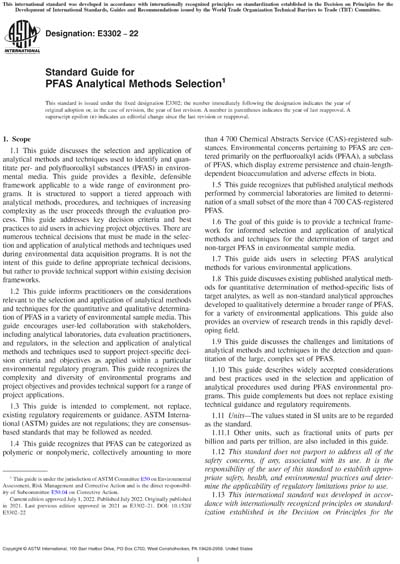Historical
ASTM E3302-22
Standard Guide for PFAS Analytical Methods Selection
1.1This guide discusses the selection and application of analytical methods and techniques used to identify and quantitate per- and polyfluoroalkyl substances (PFAS) in environmental media. This guide provides a flexible, defensible framework applicable to a wide range of environment programs. It is structured to support a tiered approach with analytical methods, procedures, and techniques of increasing complexity as the user proceeds through the evaluation process. This guide addresses key decision criteria and best practices to aid users in achieving project objectives. There are numerous technical decisions that must be made in the selection and application of analytical methods and techniques used during environmental data acquisition programs. It is not the intent of this guide to define appropriate technical decisions, but rather to provide technical support within existing decision frameworks.
1.2This guide informs practitioners on the considerations relevant to the selection and application of analytical methods and techniques for the quantitative and qualitative determination of PFAS in a variety of environmental sample media. This guide encourages user-led collaboration with stakeholders, including analytical laboratories, data evaluation practitioners, and regulators, in the selection and application of analytical methods and techniques used to support project-specific decision criteria and objectives as applied within a particular environmental regulatory program. This guide recognizes the complexity and diversity of environmental programs and project objectives and provides technical support for a range of project applications.
1.3This guide is intended to complement, not replace, existing regulatory requirements or guidance. ASTM International (ASTM) guides are not regulations; they are consensus-based standards that may be followed as needed.
1.4This guide recognizes that PFAS can be categorized as polymeric or nonpolymeric, collectively amounting to more than 4 700 Chemical Abstracts Service (CAS)-registered substances. Environmental concerns pertaining to PFAS are centered primarily on the perfluoroalkyl acids (PFAA), a subclass of PFAS, which display extreme persistence and chain-length-dependent bioaccumulation and adverse effects in biota.
1.5This guide recognizes that published analytical methods performed by commercial laboratories are limited to determination of a small subset of the more than 4 700 CAS-registered PFAS.
1.6The goal of this guide is to provide a technical framework for informed selection and application of analytical methods and techniques for the determination of target and non-target PFAS in environmental sample media.
1.7This guide aids users in selecting PFAS analytical methods for various environmental applications.
1.8This guide discusses existing published analytical methods for quantitative determination of method-specific lists of target analytes, as well as non-standard analytical approaches developed to qualitatively determine a broader range of PFAS, for a variety of environmental applications. This guide also provides an overview of research trends in this rapidly developing field.
1.9This guide discusses the challenges and limitations of analytical methods and techniques in the detection and quantitation of the large, complex set of PFAS.
1.10This guide describes widely accepted considerations and best practices used in the selection and application of analytical procedures used during PFAS environmental programs. This guide complements but does not replace existing technical guidance and regulatory requirements.
1.11Units - The values stated in SI units are to be regarded as the standard.
1.11.1Other units, such as fractional units of parts per billion and parts per trillion, are also included in this guide.
1.12This standard does not purport to address all of the safety concerns, if any, associated with its use. It is the responsibility of the user of this standard to establish appropriate safety, health, and environmental practices and determine the applicability of regulatory limitations prior to use.
1.13This international standard was developed in accordance with internationally recognized principles on standardization established in the Decision on Principles for the Development of International Standards, Guides and Recommendations issued by the World Trade Organization Technical Barriers to Trade (TBT) Committee.
Content Provider
ASTM International [astm]






